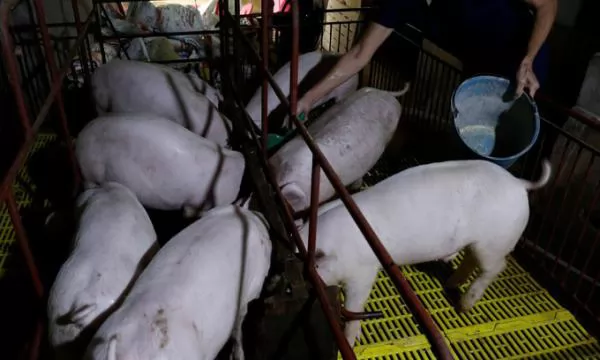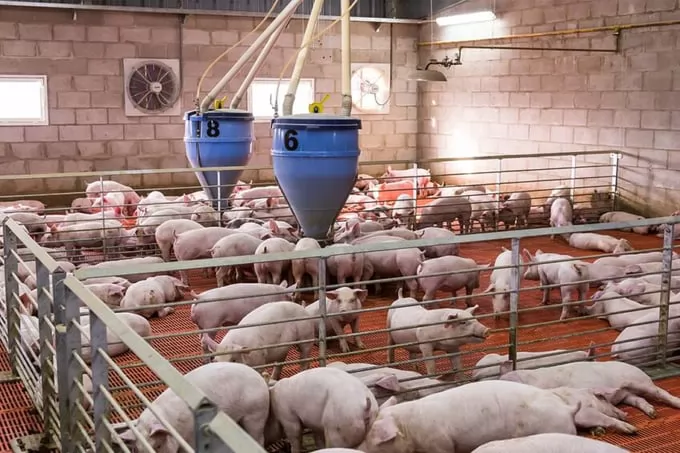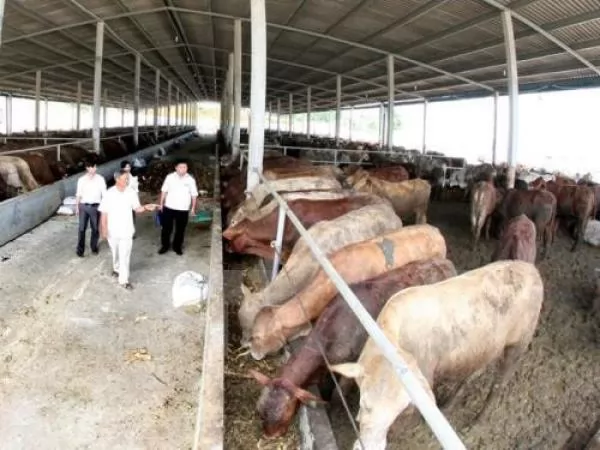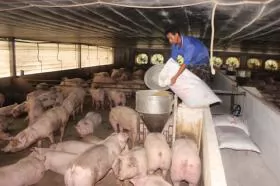Vietnam protects breeding pigs amidst African swine fever outbreak

Pigs are fed at a farm outside Hanoi, Vietnam, September 20, 2019. Photo by Reuters/Kham.
109,000 purebred pigs have been kept safe to help Vietnam rebuild its herd after the decimation caused by African swine flu, an incurable disease.
The disease was first detected in Vietnam in the northern province of Hung Yen in February. The nation has since culled 5.7 million pigs weighing over 290,000 tons, or 13 percent of the national pig stock and around 8 percent of the total pork output.
The incurable disease had spread to all 63 localities by September. As of July, the nation has suffered losses estimated at over VND3.6 trillion ($155 million) from killing 2.83 million pigs nationwide.
The agriculture sector selected 109,000 purebred pigs and placed them under strict quarantine to have capital for future breeding, Minister of Agriculture and Rural Development Nguyen Xuan Cuong told legislators at a National Assembly session Wednesday.
He praised the Ministry of Finance for disbursing VND2.37 trillion ($102.24 million) in time to support farmers in 18 hardest hit localities.
The financial aid has also facilitated the process of protecting and maintaining the herd of breeding pigs, Cuong added.
The ministry is yet to get updated data on the number of localities that are still affected by the disease after September.
It has been reported that the disease has returned to some localities.
Last Sunday, it returned to Hanoi after the capital city had spent up to VND1 trillion ($43.14 million) helping farmers kill and dispose of infected pigs and quarantining healthy ones.
As of October 31, it was detected in over 32,000 farming households which make up 40 percent of the city's total in 24 districts, and 500,000 pigs, or 30 percent of the city's herd, were killed.
With 1.9 million pigs, Hanoi has the nation's second biggest pig population after the southern province of Dong Nai, which has more than 2.5 million.
The African swine fever virus is shed in blood, saliva, tears, nasal secretions, urine, feces, and secretions from the animal's genital tract. Pigs can thus get infected by mere contact with many different infected sources, mainly other infected pigs, pork and other pig-derived products, but also any other contaminated objects, according to the Food and Agriculture Organization.
Pork makes up three-quarters of total meat consumption in Vietnam, a country of 95 million people where most of its farm-raised pigs are consumed domestically.
The country's pork industry is valued at VND94 trillion ($4 billion), and accounts for nearly 10 percent of its agricultural sector.
With the domestic pork market hit hard by the viral disease, Vietnam has seen pork from Brazil, the U.S. and Poland pouring in at lower than domestic prices.
By mid-October, HCMC had imported 10,820 tons of pork worth $21.3 million this year, up 155 percent year-on-year, according to the city's customs department. Brazil accounted for 52.5 percent total volume, followed by Poland at 13.8 percent and the U.S. at 10.2 percent.
African swine fever was first detected in Asia last year in China, the world's largest pork producer. As many as half of China's breeding pigs have died or been slaughtered because of the disease, twice as many as officially reported.
Data from the World Organization for Animal Health shows that as of October 30, new or ongoing outbreaks have been detected in 12 countries and territories: Cambodia, mainland China, Hong Kong, North Korea, South Korea, Laos, Mongolia, Myanama, the Philippines, Russia, Timor-Leste, and Vietnam and 4.27 million pigs have been culled.
The Vietnam National University of Agriculture started researching a vaccine for the disease in March this year. Thus far, it has developed four kinds of vaccines, one of which has shown good results among 13 out of 14 pigs tested, it said at a meeting last July.
Source: here
Maybe you are interested

A swine of the times - pig production down in An Giang Province
AN GIANG — Pig breeders in the southern province of An Giang are struggling to deal with the combined impacts of the COVID-19 pandemic, diseases in herds and falling pig prices.

Competition on Chinese pork market gets fiercer
Russian pig farmers brace themselves for a tussle with US and European companies in China in 2024, according to business organisations.

Cow breeding yields high income for farmers in Tiền Giang
Viet Nam News / HCM CITY — Farmers who breed oxen and raise cows in the Cửu Long (Mekong) Delta province of Tiền Giang have greatly improved their income.





